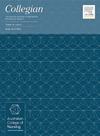Metrics used by nurse practitioners to evaluate the impact of their role: A scoping review
IF 1.7
4区 医学
Q2 NURSING
引用次数: 0
Abstract
Background
The link between the care provided by nurse practitioners and its impact on patient outcomes is not clear.
Aim
To identify what metrics are currently being used by nurse practitioners to evaluate their practice.
Design
Scoping review guided by Joanna Briggs Institute methodology.
Methods
The population, concept, and context framework was used to guide keyword and index terms used. Metrics used to evaluate nurse practitioner practice and methods used in quantitative and qualitative studies, published in English between 2017 and 2023, were included. A content analysis was performed to identify metrics common to all nurse practitioners.
Data sources
Medline, CINAHL, Embase, and the Joanna Briggs Institute Evidence-Based Practice Database were searched in July 2024. Grey literature was identified by searching Open Dissertations and Google Scholar.
Results
Of the 2742 articles identified, 83 met the aim of this review. Most publications originated from the United States (n=46). No studies indicated consumer involvement in study design. Data analysis of the 294 metrics identified 17 themes. All themes were aligned to Donabedian’s categories of structure (n=2), process (n=9), and outcome (n=6).
Conclusions
Nurse practitioners are evaluating their specialty practice using a variety of metrics via quality assurance and observational design where the comparator is medicine. A lack of consumer involvement in practice evaluation was noted in this review. Metrics, co-designed with consumers, that measure nurse practitioner practice regardless of specialty is lacking throughout the literature and is desperately needed.
执业护士用于评估其角色影响的指标:范围审查
护士从业人员提供的护理与其对患者预后的影响之间的联系尚不清楚。目的确定护士从业人员目前正在使用哪些指标来评估其实践。设计范围审查由乔安娜布里格斯研究所的方法指导。方法采用人口、概念和上下文框架来指导关键词和索引术语的使用。纳入了2017年至2023年间以英文发表的用于评估护士执业实践的指标以及定量和定性研究中使用的方法。进行内容分析以确定所有护士从业人员共有的指标。数据来源:medline、CINAHL、Embase和Joanna Briggs研究所循证实践数据库于2024年7月检索。灰色文献是通过搜索Open dissertation和b谷歌Scholar来确定的。在2742篇纳入的文献中,有83篇符合本综述的目的。大多数出版物来自美国(n=46)。没有研究表明消费者参与了研究设计。对294个指标的数据分析确定了17个主题。所有主题都与Donabedian的结构(n=2)、过程(n=9)和结果(n=6)类别一致。结论:执业护士正在通过质量保证和观察性设计评估其专业实践的各种指标,其中比较物是医学。本综述指出,消费者在实践评价中缺乏参与。与消费者共同设计的衡量护士执业实践的指标,无论专业如何,在整个文献中都是缺乏的,也是迫切需要的。
本文章由计算机程序翻译,如有差异,请以英文原文为准。
求助全文
约1分钟内获得全文
求助全文
来源期刊

Collegian
NURSING-
CiteScore
2.70
自引率
6.70%
发文量
127
审稿时长
72 days
期刊介绍:
Collegian: The Australian Journal of Nursing Practice, Scholarship and Research is the official journal of Australian College of Nursing (ACN).
The journal aims to reflect the broad interests of nurses and the nursing profession, and to challenge nurses on emerging areas of interest. It publishes research articles and scholarly discussion of nursing practice, policy and professional issues.
Papers published in the journal are peer reviewed by a double blind process using reviewers who meet high standards of academic and clinical expertise. Invited papers that contribute to nursing knowledge and debate are published at the discretion of the Editor.
The journal, online only from 2016, is available to members of ACN and also by separate subscription.
ACN believes that each and every nurse in Australia should have the opportunity to grow their career through quality education, and further our profession through representation. ACN is the voice of influence, providing the nursing expertise and experience required when government and key stakeholders are deciding the future of health.
 求助内容:
求助内容: 应助结果提醒方式:
应助结果提醒方式:


